2017 NISSAN QUEST warning
[x] Cancel search: warningPage 46 of 520
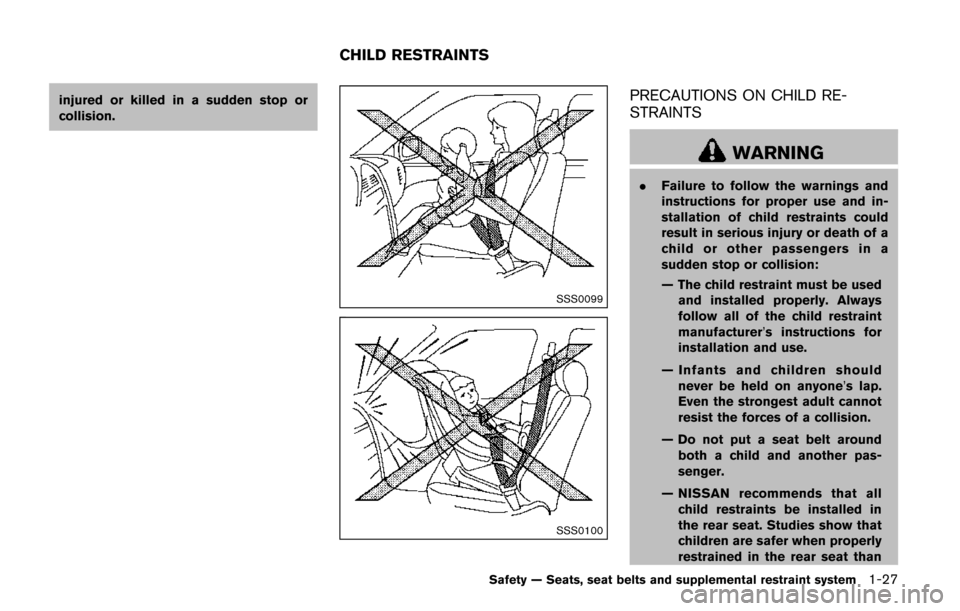
injured or killed in a sudden stop or
collision.
SSS0099
SSS0100
PRECAUTIONS ON CHILD RE-
STRAINTS
WARNING
.Failure to follow the warnings and
instructions for proper use and in-
stallation of child restraints could
result in serious injury or death of a
child or other passengers in a
sudden stop or collision:
— The child restraint must be used
and installed properly. Always
follow all of the child restraint
manufacturer’s instructions for
installation and use.
— Infants and children should never be held on anyone’s lap.
Even the strongest adult cannot
resist the forces of a collision.
— Do not put a seat belt around both a child and another pas-
senger.
— NISSAN recommends that all child restraints be installed in
the rear seat. Studies show that
children are safer when properly
restrained in the rear seat than
Safety — Seats, seat belts and supplemental restraint system1-27
CHILD RESTRAINTS
Page 48 of 520
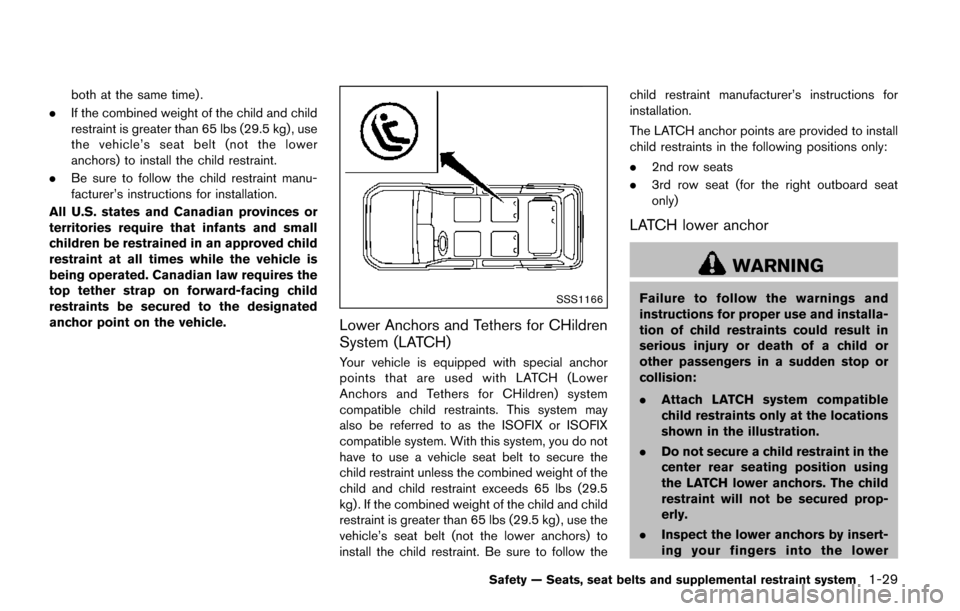
both at the same time) .
. If the combined weight of the child and child
restraint is greater than 65 lbs (29.5 kg) , use
the vehicle’s seat belt (not the lower
anchors) to install the child restraint.
. Be sure to follow the child restraint manu-
facturer’s instructions for installation.
All U.S. states and Canadian provinces or
territories require that infants and small
children be restrained in an approved child
restraint at all times while the vehicle is
being operated. Canadian law requires the
top tether strap on forward-facing child
restraints be secured to the designated
anchor point on the vehicle.
SSS1166
Lower Anchors and Tethers for CHildren
System (LATCH)
Your vehicle is equipped with special anchor
points that are used with LATCH (Lower
Anchors and Tethers for CHildren) system
compatible child restraints. This system may
also be referred to as the ISOFIX or ISOFIX
compatible system. With this system, you do not
have to use a vehicle seat belt to secure the
child restraint unless the combined weight of the
child and child restraint exceeds 65 lbs (29.5
kg) . If the combined weight of the child and child
restraint is greater than 65 lbs (29.5 kg) , use the
vehicle’s seat belt (not the lower anchors) to
install the child restraint. Be sure to follow the child restraint manufacturer’s instructions for
installation.
The LATCH anchor points are provided to install
child restraints in the following positions only:
.
2nd row seats
. 3rd row seat (for the right outboard seat
only)
LATCH lower anchor
WARNING
Failure to follow the warnings and
instructions for proper use and installa-
tion of child restraints could result in
serious injury or death of a child or
other passengers in a sudden stop or
collision:
.Attach LATCH system compatible
child restraints only at the locations
shown in the illustration.
. Do not secure a child restraint in the
center rear seating position using
the LATCH lower anchors. The child
restraint will not be secured prop-
erly.
. Inspect the lower anchors by insert-
ing your fingers into the lower
Safety — Seats, seat belts and supplemental restraint system1-29
Page 51 of 520
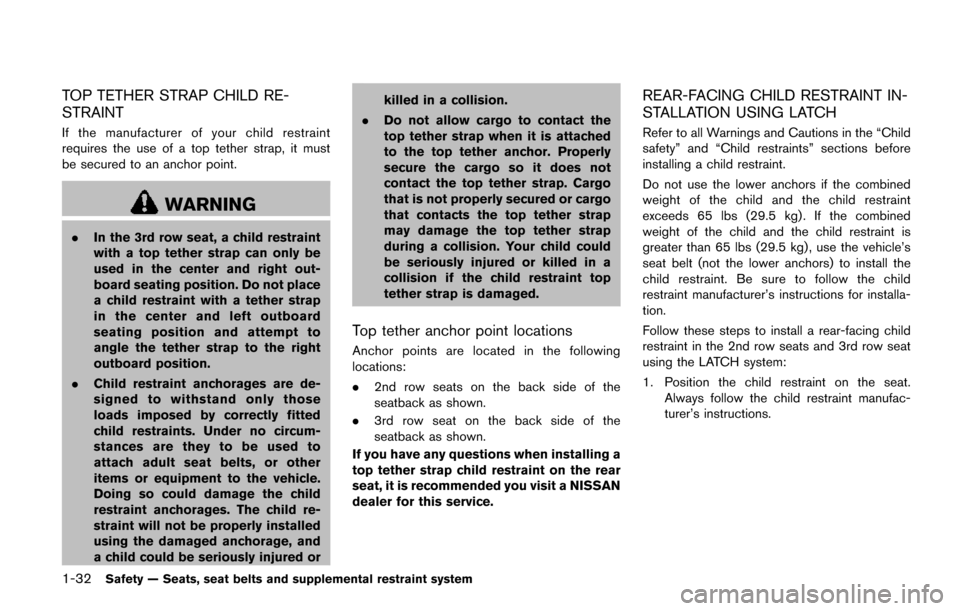
1-32Safety — Seats, seat belts and supplemental restraint system
TOP TETHER STRAP CHILD RE-
STRAINT
If the manufacturer of your child restraint
requires the use of a top tether strap, it must
be secured to an anchor point.
WARNING
.In the 3rd row seat, a child restraint
with a top tether strap can only be
used in the center and right out-
board seating position. Do not place
a child restraint with a tether strap
in the center and left outboard
seating position and attempt to
angle the tether strap to the right
outboard position.
. Child restraint anchorages are de-
signed to withstand only those
loads imposed by correctly fitted
child restraints. Under no circum-
stances are they to be used to
attach adult seat belts, or other
items or equipment to the vehicle.
Doing so could damage the child
restraint anchorages. The child re-
straint will not be properly installed
using the damaged anchorage, and
a child could be seriously injured or killed in a collision.
. Do not allow cargo to contact the
top tether strap when it is attached
to the top tether anchor. Properly
secure the cargo so it does not
contact the top tether strap. Cargo
that is not properly secured or cargo
that contacts the top tether strap
may damage the top tether strap
during a collision. Your child could
be seriously injured or killed in a
collision if the child restraint top
tether strap is damaged.
Top tether anchor point locations
Anchor points are located in the following
locations:
.2nd row seats on the back side of the
seatback as shown.
. 3rd row seat on the back side of the
seatback as shown.
If you have any questions when installing a
top tether strap child restraint on the rear
seat, it is recommended you visit a NISSAN
dealer for this service.
REAR-FACING CHILD RESTRAINT IN-
STALLATION USING LATCH
Refer to all Warnings and Cautions in the “Child
safety” and “Child restraints” sections before
installing a child restraint.
Do not use the lower anchors if the combined
weight of the child and the child restraint
exceeds 65 lbs (29.5 kg) . If the combined
weight of the child and the child restraint is
greater than 65 lbs (29.5 kg) , use the vehicle’s
seat belt (not the lower anchors) to install the
child restraint. Be sure to follow the child
restraint manufacturer’s instructions for installa-
tion.
Follow these steps to install a rear-facing child
restraint in the 2nd row seats and 3rd row seat
using the LATCH system:
1. Position the child restraint on the seat. Always follow the child restraint manufac-
turer’s instructions.
Page 53 of 520
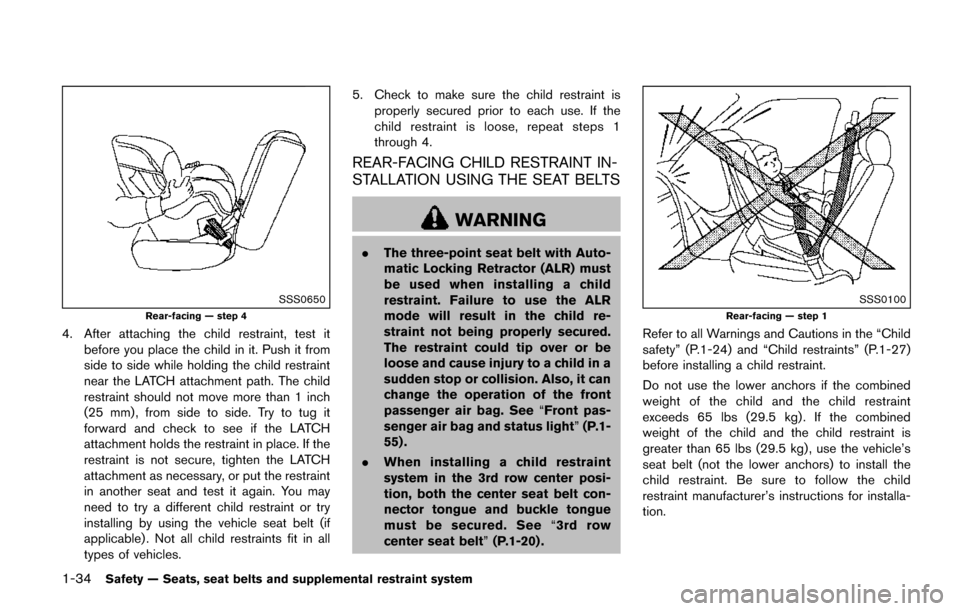
1-34Safety — Seats, seat belts and supplemental restraint system
SSS0650
Rear-facing — step 4
4. After attaching the child restraint, test itbefore you place the child in it. Push it from
side to side while holding the child restraint
near the LATCH attachment path. The child
restraint should not move more than 1 inch
(25 mm) , from side to side. Try to tug it
forward and check to see if the LATCH
attachment holds the restraint in place. If the
restraint is not secure, tighten the LATCH
attachment as necessary, or put the restraint
in another seat and test it again. You may
need to try a different child restraint or try
installing by using the vehicle seat belt (if
applicable) . Not all child restraints fit in all
types of vehicles. 5. Check to make sure the child restraint is
properly secured prior to each use. If the
child restraint is loose, repeat steps 1
through 4.
REAR-FACING CHILD RESTRAINT IN-
STALLATION USING THE SEAT BELTS
WARNING
.The three-point seat belt with Auto-
matic Locking Retractor (ALR) must
be used when installing a child
restraint. Failure to use the ALR
mode will result in the child re-
straint not being properly secured.
The restraint could tip over or be
loose and cause injury to a child in a
sudden stop or collision. Also, it can
change the operation of the front
passenger air bag. See “Front pas-
senger air bag and status light ”(P.1-
55) .
. When installing a child restraint
system in the 3rd row center posi-
tion, both the center seat belt con-
nector tongue and buckle tongue
must be secured. See “3rd row
center seat belt” (P.1-20) .
SSS0100
Rear-facing — step 1
Refer to all Warnings and Cautions in the “Child
safety” (P.1-24) and “Child restraints” (P.1-27)
before installing a child restraint.
Do not use the lower anchors if the combined
weight of the child and the child restraint
exceeds 65 lbs (29.5 kg) . If the combined
weight of the child and the child restraint is
greater than 65 lbs (29.5 kg) , use the vehicle’s
seat belt (not the lower anchors) to install the
child restraint. Be sure to follow the child
restraint manufacturer’s instructions for installa-
tion.
Page 56 of 520
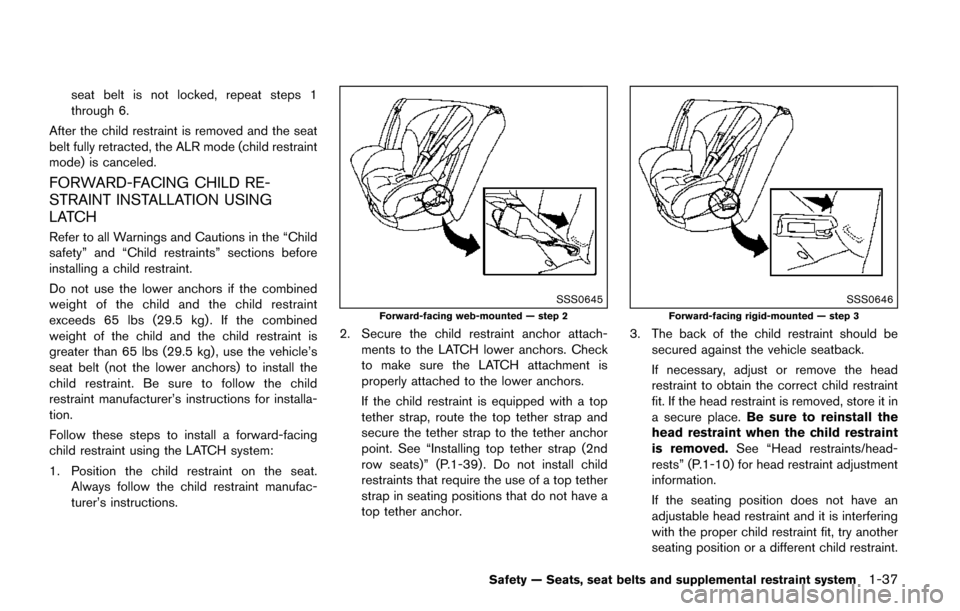
seat belt is not locked, repeat steps 1
through 6.
After the child restraint is removed and the seat
belt fully retracted, the ALR mode (child restraint
mode) is canceled.
FORWARD-FACING CHILD RE-
STRAINT INSTALLATION USING
LATCH
Refer to all Warnings and Cautions in the “Child
safety” and “Child restraints” sections before
installing a child restraint.
Do not use the lower anchors if the combined
weight of the child and the child restraint
exceeds 65 lbs (29.5 kg) . If the combined
weight of the child and the child restraint is
greater than 65 lbs (29.5 kg) , use the vehicle’s
seat belt (not the lower anchors) to install the
child restraint. Be sure to follow the child
restraint manufacturer’s instructions for installa-
tion.
Follow these steps to install a forward-facing
child restraint using the LATCH system:
1. Position the child restraint on the seat. Always follow the child restraint manufac-
turer’s instructions.
SSS0645
Forward-facing web-mounted — step 2
2. Secure the child restraint anchor attach-ments to the LATCH lower anchors. Check
to make sure the LATCH attachment is
properly attached to the lower anchors.
If the child restraint is equipped with a top
tether strap, route the top tether strap and
secure the tether strap to the tether anchor
point. See “Installing top tether strap (2nd
row seats)” (P.1-39) . Do not install child
restraints that require the use of a top tether
strap in seating positions that do not have a
top tether anchor.
SSS0646
Forward-facing rigid-mounted — step 3
3. The back of the child restraint should besecured against the vehicle seatback.
If necessary, adjust or remove the head
restraint to obtain the correct child restraint
fit. If the head restraint is removed, store it in
a secure place. Be sure to reinstall the
head restraint when the child restraint
is removed. See “Head restraints/head-
rests” (P.1-10) for head restraint adjustment
information.
If the seating position does not have an
adjustable head restraint and it is interfering
with the proper child restraint fit, try another
seating position or a different child restraint.
Safety — Seats, seat belts and supplemental restraint system1-37
Page 58 of 520
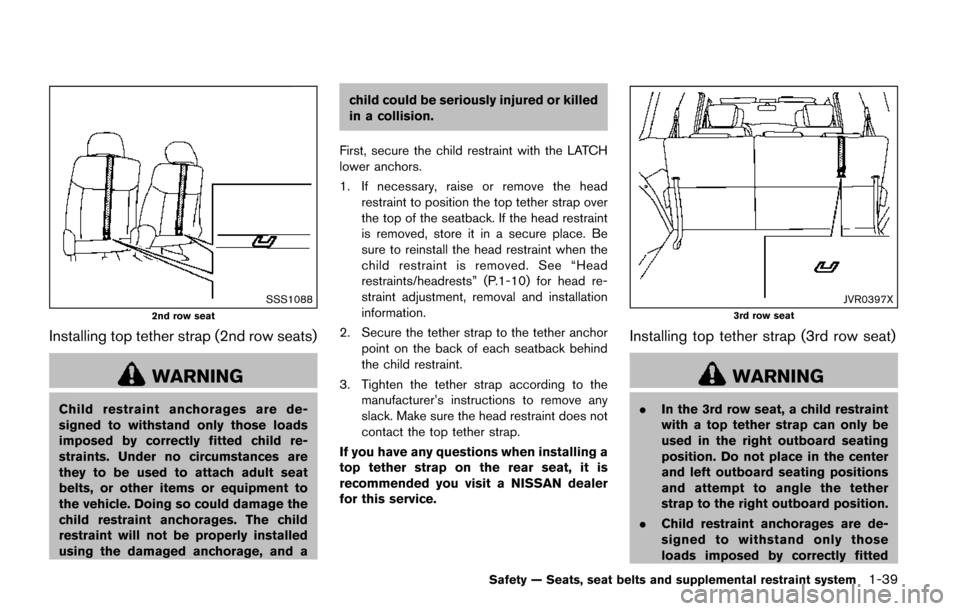
SSS1088
2nd row seat
Installing top tether strap (2nd row seats)
WARNING
Child restraint anchorages are de-
signed to withstand only those loads
imposed by correctly fitted child re-
straints. Under no circumstances are
they to be used to attach adult seat
belts, or other items or equipment to
the vehicle. Doing so could damage the
child restraint anchorages. The child
restraint will not be properly installed
using the damaged anchorage, and achild could be seriously injured or killed
in a collision.
First, secure the child restraint with the LATCH
lower anchors.
1. If necessary, raise or remove the head restraint to position the top tether strap over
the top of the seatback. If the head restraint
is removed, store it in a secure place. Be
sure to reinstall the head restraint when the
child restraint is removed. See “Head
restraints/headrests” (P.1-10) for head re-
straint adjustment, removal and installation
information.
2. Secure the tether strap to the tether anchor point on the back of each seatback behind
the child restraint.
3. Tighten the tether strap according to the manufacturer’s instructions to remove any
slack. Make sure the head restraint does not
contact the top tether strap.
If you have any questions when installing a
top tether strap on the rear seat, it is
recommended you visit a NISSAN dealer
for this service.
JVR0397X
3rd row seat
Installing top tether strap (3rd row seat)
WARNING
. In the 3rd row seat, a child restraint
with a top tether strap can only be
used in the right outboard seating
position. Do not place in the center
and left outboard seating positions
and attempt to angle the tether
strap to the right outboard position.
. Child restraint anchorages are de-
signed to withstand only those
loads imposed by correctly fitted
Safety — Seats, seat belts and supplemental restraint system1-39
Page 59 of 520
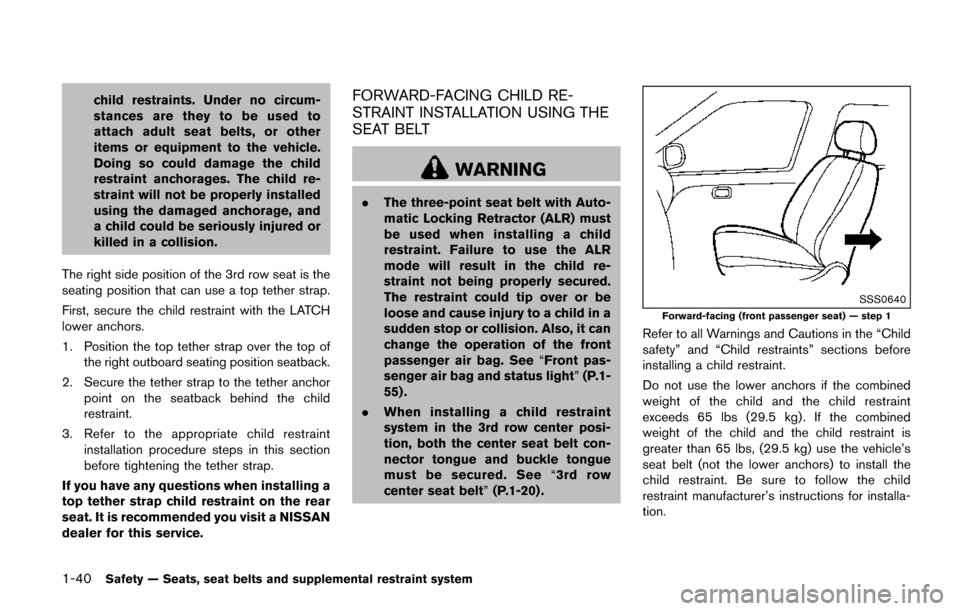
1-40Safety — Seats, seat belts and supplemental restraint system
child restraints. Under no circum-
stances are they to be used to
attach adult seat belts, or other
items or equipment to the vehicle.
Doing so could damage the child
restraint anchorages. The child re-
straint will not be properly installed
using the damaged anchorage, and
a child could be seriously injured or
killed in a collision.
The right side position of the 3rd row seat is the
seating position that can use a top tether strap.
First, secure the child restraint with the LATCH
lower anchors.
1. Position the top tether strap over the top of the right outboard seating position seatback.
2. Secure the tether strap to the tether anchor point on the seatback behind the child
restraint.
3. Refer to the appropriate child restraint installation procedure steps in this section
before tightening the tether strap.
If you have any questions when installing a
top tether strap child restraint on the rear
seat. It is recommended you visit a NISSAN
dealer for this service.FORWARD-FACING CHILD RE-
STRAINT INSTALLATION USING THE
SEAT BELT
WARNING
. The three-point seat belt with Auto-
matic Locking Retractor (ALR) must
be used when installing a child
restraint. Failure to use the ALR
mode will result in the child re-
straint not being properly secured.
The restraint could tip over or be
loose and cause injury to a child in a
sudden stop or collision. Also, it can
change the operation of the front
passenger air bag. See “Front pas-
senger air bag and status light ”(P.1-
55) .
. When installing a child restraint
system in the 3rd row center posi-
tion, both the center seat belt con-
nector tongue and buckle tongue
must be secured. See “3rd row
center seat belt” (P.1-20) .
SSS0640
Forward-facing (front passenger seat) — step 1
Refer to all Warnings and Cautions in the “Child
safety” and “Child restraints” sections before
installing a child restraint.
Do not use the lower anchors if the combined
weight of the child and the child restraint
exceeds 65 lbs (29.5 kg) . If the combined
weight of the child and the child restraint is
greater than 65 lbs, (29.5 kg) use the vehicle’s
seat belt (not the lower anchors) to install the
child restraint. Be sure to follow the child
restraint manufacturer’s instructions for installa-
tion.
Page 63 of 520
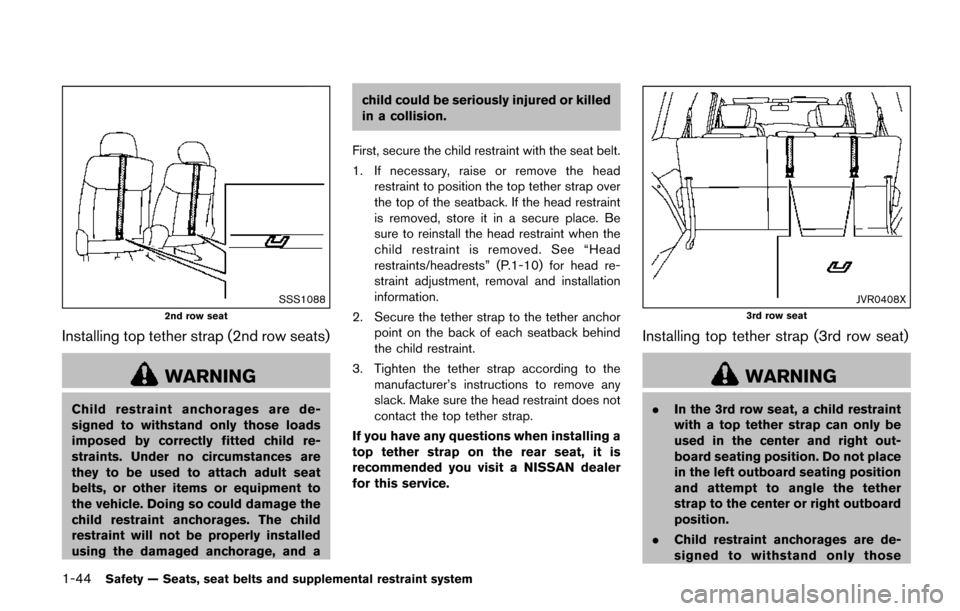
1-44Safety — Seats, seat belts and supplemental restraint system
SSS1088
2nd row seat
Installing top tether strap (2nd row seats)
WARNING
Child restraint anchorages are de-
signed to withstand only those loads
imposed by correctly fitted child re-
straints. Under no circumstances are
they to be used to attach adult seat
belts, or other items or equipment to
the vehicle. Doing so could damage the
child restraint anchorages. The child
restraint will not be properly installed
using the damaged anchorage, and achild could be seriously injured or killed
in a collision.
First, secure the child restraint with the seat belt.
1. If necessary, raise or remove the head restraint to position the top tether strap over
the top of the seatback. If the head restraint
is removed, store it in a secure place. Be
sure to reinstall the head restraint when the
child restraint is removed. See “Head
restraints/headrests” (P.1-10) for head re-
straint adjustment, removal and installation
information.
2. Secure the tether strap to the tether anchor point on the back of each seatback behind
the child restraint.
3. Tighten the tether strap according to the manufacturer’s instructions to remove any
slack. Make sure the head restraint does not
contact the top tether strap.
If you have any questions when installing a
top tether strap on the rear seat, it is
recommended you visit a NISSAN dealer
for this service.
JVR0408X
3rd row seat
Installing top tether strap (3rd row seat)
WARNING
. In the 3rd row seat, a child restraint
with a top tether strap can only be
used in the center and right out-
board seating position. Do not place
in the left outboard seating position
and attempt to angle the tether
strap to the center or right outboard
position.
. Child restraint anchorages are de-
signed to withstand only those